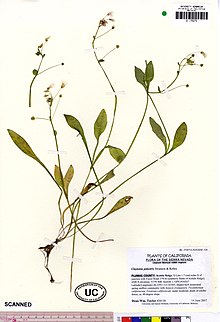Claytonia palustris
| Claytonia palustris | |
|---|---|

| |
| Scientific classification | |
| Kingdom: | Plantae |
| Clade: | Tracheophytes |
| Clade: | Angiosperms |
| Clade: | Eudicots |
| Order: | Caryophyllales |
| Family: | Montiaceae |
| Genus: | Claytonia |
| Species: | C. palustris
|
| Binomial name | |
| Claytonia palustris Swanson & Kelley
| |
Claytonia palustris is a species of wildflower in the family Montiaceae known by the common names Jonesville springbeauty and marsh claytonia.
Distribution
The wildflower is endemic to California where it is an uncommon member of the flora in wet areas such as spring meadows in the high mountains from the Klamath Range to the High Sierra. The species epithet palustris is Latin for "of the marsh" and indicates its common habitat.[1] The species is diploid (2n = 12) with a chromosome base number of x = 6.[2]
Description
Claytonia palustris is a rhizomatous perennial herb producing a slender stem up to about 0.5 metres (1.6 ft) long.
It has leaves with oval-shaped blades a few centimeters long at the ends of long, narrow petioles.
The inflorescence bears up to 18 flowers on a long stalk. Each flower has 5 white or pink-tinted white petals just under a centimeter long. The bloom period is May to October.
References
- ^ Archibald William Smith A Gardener's Handbook of Plant Names: Their Meanings and Origins, p. 258, at Google Books
- ^ Miller, J. M. and K. L. Chambers. 2006. Systematics of Claytonia (Portulacaceae). Systematic Botany Monographs 78: 1-236. ISBN 0-912861-78-9
External links
- Calflora Database: Claytonia palustris (Jonesville springbeauty, Marsh claytonia)
- Jepson Manual Treatment
- Flora North America
- Photo gallery
